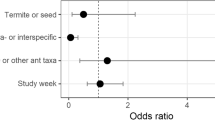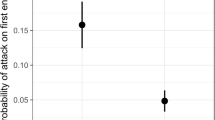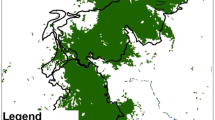Abstract
Predation pressure from ants is a major driving force in the adaptive evolution of termite defense strategies and termites have evolved elaborate chemical and physical defenses to protect themselves against ants. We examined predator–prey interactions between the woodland ant, Aphaenogaster rudis (Emery) and the eastern subterranean termite, Reticulitermes flavipes (Kollar), two sympatric species widely distributed throughout deciduous forests in eastern North America. To examine the behavioral interactions between A. rudis and R. flavipes we used a series of laboratory behavioral assays and predation experiments where A. rudis and R. flavipes could interact individually or in groups. One-on-one aggression tests revealed that R. flavipes are vulnerable to predation by A. rudis when individual termite workers or soldiers are exposed to ant attacks in open dishes and 100% of termite workers and soldiers died, even though the soldiers were significantly more aggressive towards the ants. The results of predation experiments where larger ant and termite colony fragments interacted provide experimental evidence for the importance of physical barriers for termite colony defense. In experiments where the termites nested within artificial nests (sand-filled containers), A. rudis was aggressive at invading termite nests and inflicted 100% mortality on the termites. In contrast, termite mortality was comparable to controls when termite colonies nested in natural nests comprised of wood blocks. Our results highlight the importance of physical barriers in termite colony defense and suggest that under natural field conditions termites may be less susceptible to attacks by ants when they nest in solid wood, which may offer more structural protection than sand alone.
Similar content being viewed by others
References
Abe TJ, Darlington PEC (1985) Distribution and abundance of a mound-building termite, Macrotermes michaelseni, with special reference to its subterranean colonies and ant predators. Physiol Ecol Japan 22:59–74
Bhatkar AD, Whitcomb WH (1970) Artificial diet for rearing various species of ants. Florida Entomol 53:229–232
Buczkowski G, Bennett GW (2007) Protein marking reveals predation on termites by the woodland ant, Aphaenogaster rudis. Insectes Soc 54:219–224
Chen J, Henderson G, Grimm CC, Lloyd SW, Laine RA (1998) Termites fumigate their nests with naphtalene. Nature 392:558–559
Collins NM (1981) Population, age structure, and survivorship of colonies of Macrotermes bellicosus (Isoptera: Macrotermitinae). J Anim Ecol 50:293–311
Cornelius ML, Grace JK (1995) Laboratory evaluations of interactions of three ant species with the Formosan subterranean termite (Isoptera: Rhinotermitidae). Sociobiology 26:291–298
Cornelius ML, Grace JK (1996) Effect of two ant species (Hymenopetra: Formicidae) on the foraging and survival of the Formosan subterranean termite (Isoptera: Rhinotermitidae). Environ Entomol 25:85–89
Cornelius ML, Grace JK (1997) Effect of termite soldiers on the foraging behavior of Coptotermes formosanus (Isoptera: Rhinotermitidae) in the presence of predatory ants. Sociobiology 29:247–253
Creighton WS (1950) The ants of North America. Bulletin of the Museum of Comparative Zoology. 585 pp
Darlington PEC (1985) Attacks by doryline ants and termite nest defenses (Hymenoptera: Formicidae, Isoptera: Termitidae). Sociobiology 11:184–200
Deligne J, Quennedey A, Blum MS (1981) The enemies and defense mechanisms of termites. In: Hermann HR (ed) Social insects. vol. 2. Academic, New York, pp 1–76
Green JM, Scharf ME, Bennett GW (2005) Impacts of soil moisture level on consumption and movement of three sympatric subterranean termites (Isoptera: Rhinotermitidae) in a laboratory assay plantations. J Econ Entomol 98:933–937
Higashi S, Ito F (1989) Defense of termitaria by termitophilous ants. Oecologia 80:145–147
Hölldobler B, Wilson EO (1990) The ants. The Belknap Press of Harvard University Press, Cambridge, MA, p 732
Holt JA, Greenslade PJM (1979) Ants in mounds of Amitermes laurensis. J Aust Entomol Soc 18:349–361
Jaffe K, Ramos C, Issa S (1995) Trophic interactions between ants and termites that share common nests. Ann Entomol Soc Am 88:328–333
Lepage M (1981) Etude de la prédation de Megaponera foetens (F.) sur les populations récoltantes de Mecrotermitinae dans un écosystème semi-aride (Kajiado—Kenya). Insectes Soc 28:247–262
Leponce M, Roisin Y, Pasteels JM (1999) Community interaction between ants and arboreal-nesting termites in New Guinea coconut plantations. Insect Soc 46:126–130
Longhurst C, Johnson RA, Wood TG (1978) Predation by Megaponera foetens (Fabr.) (Hymenoptera: Formicidae) on termites in the Nigerian Southern Guinea savanna. Oecologia 32:101–107
Longhurst C, Johnson RA, Wood TG (1979) Foraging, recruitment, and predation by Decamorium uelense (Sanstchi) (Formicidae: Myrmicinae) on termites in Southern Guinea savanna, Nigeria. Oecologia 38:83–91
Lynch JF (1981) Seasonal, successional, and vertical segregation in a Maryland ant community. Oikos 37:183–198
Mill AE (1983) Behavioural and toxic effects of termite defensive secretions on ants. Physiol Entomol 8:413–418
Nutting WL (1990) Insecta, isoptera. In: Dindal DL (ed) Soil biology guide. Wiley, New York, pp 997–1032
Noirot C (1970). In: Krishna K, Weesner FM (eds) Biology of termites. vol. 2. Academic, New York, p 643
Prestwich GD (1984) Defense mechanisms of termites. Annu Rev Entomol 29:210–223
Quinet Y, Tekule N, de Biseau CJ (2005) Behavioural interactions between Crematogaster brevispinosa rochai Forel (Hymenoptera: Formicidae) and two Nasutitermes species (Isoptera: Termitidae). J Insect Behav 18:1–17
Roulston TH, Buczkowski G, Silverman J (2003) Nestmate discrimination in ants: effect of bioassay on aggressive behavior. Insectes Soc 50:151–159
SAS Institute (2002) SAS/STAT guide for personal computers, version 8.1. SAS Institute, Cary, NC
Sheppe W (1970) Invertebrate predation on termites of the African savanna. Insectes Soc 17:205–218
Suarez AV, Tsutsui ND, Holway DA, Case TJ (1999) Behavioral and genetic differentiation between native and introduced populations of the Argentine ant. Biol Invasions 1:1–11
Wells JD, Henderson G (1993) Fire ant predation on native and introduced subterranean termites in the laboratory: effect of high soldier number in Coptotermes formosanus. Ecol Entomol 18:270–274
Wheeler WM (1936) Ecological relations of ponerine and other ants to termites. Proc Am Acad Arts Sci 71:159–243
Acknowledgements
We thank members of the Urban Center and two anonymous reviewers for helpful comments on the manuscript, C. Wang for help identifying ant specimens, M. McDonough for collecting and maintaining termite colonies, and T. Clough for statistical advice. Financial support was provided in part by the Industrial Affiliates Program at Purdue University.
Author information
Authors and Affiliations
Corresponding author
Rights and permissions
About this article
Cite this article
Buczkowski, G., Bennett, G. Behavioral Interactions Between Aphaenogaster rudis (Hymenoptera: Formicidae) and Reticulitermes flavipes (Isoptera: Rhinotermitidae): The Importance of Physical Barriers. J Insect Behav 21, 296–305 (2008). https://doi.org/10.1007/s10905-008-9127-2
Revised:
Accepted:
Published:
Issue Date:
DOI: https://doi.org/10.1007/s10905-008-9127-2




